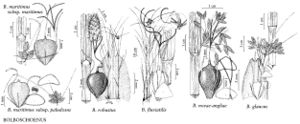Bolboschoenus fluviatilis
Cas. Nár. Mus., Odd. Prír. 141: 62. 1972.
Culms 100–200 cm × 5–15 mm. Leaves: sheaths reaching to middle of culm or higher, fronts convex (to concave) and papery at mouth, veins reaching apex, very rarely diverging leaving triangular, veinless, membranous area; widest blade 7–22 mm wide. Inflorescences subumbellate, with all or most spikelets solitary or in clusters of 2–3(–8) on 4–12 rays, rays not exceeding 10 cm; involucral bracts that surpass inflorescences 3–6, widest bract 4–15 mm wide. Spikelets 10–40, ovoid to lanceoloid, 10–25 × 6–10 mm, base cuneate to rounded; scales often loosely imbricate, orange-brown to stramineous, usually obscurely lineolate-spotted, 7–10 × 3–4 mm, membranous and translucent, apex 2-fid 0.5–1 mm deep, awns fairly stout, 2–3 × 0.5 mm wide at base. Flowers: perianth bristles tightly attached to shed achene, pale brown, very stout, equaling achene; anthers yellow, 4 mm; styles 3-fid. Achenes grayish or dark brown, often in patches, obovoid to obpyriform, all nearly equilaterally markedly trigonous to slightly compressed, angles equally rounded, 3.8–5.5 × 2–2.9 mm, apex rounded, beak 0.2–0.8 mm, surface rather dull, exocarp cells usually not evident at 20X; in cross section exocarp much thinner than mesocarp and its cells very small, isodiametric; achene specific gravity greater than water. 2n = 94.
Phenology: Fruiting summer.
Habitat: Fresh shores, inland marshes, coastal estuaries
Elevation: 0–2100 m
Distribution

Alta., B.C., Man., N.B., Ont., Que., Sask., Ala., Ariz., Calif., Colo., Conn., Del., Idaho, Ill., Ind., Iowa, Kans., Maine, Md., Mass., Mich., Minn., Mo., Mont., Nebr., N.H., N.J., N.Y., N.Dak., Ohio, Oreg., Pa., S.Dak., Tenn., Utah, Vt., Va., Wash., Wis., Asia (Japan), Australia, Pacific Islands (New Zealand).
Discussion
Bolboschoenus fluviatilis frequently forms dense, monospecific, often entirely vegetative stands, and it is more common than recorded because vegetative colonies are often overlooked (E. W. Chester and B. E. Wofford 1992). The only record for Alabama is an 1870 collection from the East Fowl River in the Mobile Delta, where the species has not been collected since. It was intentionally introduced into New Hampshire (D. J. Padgett and G. E. Crow 1993). The report from New Mexico by M. L. Fernald (1950) cannot be confirmed because no specimen is known.
Putative hybrids with Bolboschoenus maritimus occur in California. Bolboschoenus novae-angliae probably originated from B. fluviatilis × B. robustus (J. Browning et al. 1995). Introgression from B. maritimus and/or B. robustus is suggested by the larger exocarp cells (evident in surface view) in some North American plants. The Eurasian B. yagara (Ohwi) Y. C. Yang & M. Zhan differs from B. fluviatilis in its narrower leaves and smaller achenes.
Selected References
None.
